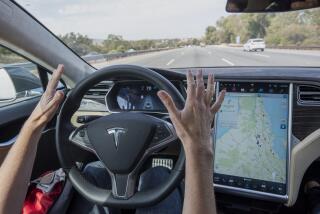Report adds support for limits on ATV sales
- Share via
As the popularity of all-terrain vehicles has skyrocketed, so have ATV-related injuries. And not surprisingly, safety activists now are calling for more restrictions on ATV sales to minors.
According to a report in January by the U.S. Consumer Product Safety Commission, the number of ATV injuries requiring emergency room treatment rose 104%, from 54,700 in 1997 to 111,700 in 2001. In that same period, annual ATV sales rose 124% to 825,000 units.
But Ken Giles, a commission spokesman, attributed only half the increase in injuries to the rise in ATV sales. The rest is due to an influx of young ATV riders inexperienced with the machines and their size.
The report found that ATV riders under age 16 face a greater risk of injury than older riders. From 1982 to 2001 some 4,541 Americans were killed while riding ATVs; 38% of those fatalities were riders under age 16.
ATVs are four-wheeled, motorcycle-derived vehicles designed to ride over rough terrain, sand or climb high dunes. They range from child-size vehicles with 50 cubic centimeter engines to adult sizes with powerful 700-cc engines. Prices range from $1,500 to about $9,000.
There also was a time when three-wheel ATVs were popular. But ATV makers agreed to stop making the three-wheelers in 1988 after the commission took them to court over safety concerns.
Among the most popular ATV and off-road vehicle spots in California are the Imperial Sand Dunes Recreation Area, Anza-Borrego Desert State Park and Pismo Beach. But the state has the dubious distinction of leading the nation in ATV-related fatalities with 278 over the last two decades, according to the commission.
The government’s findings are timely. A coalition of medical, consumer and environmental groups previously had urged the CPSC to ban the sale of adult-size ATVs to those under 16. “The report confirms that ATVs are dangerous, especially for children,” said Rachel Weintraub, spokeswoman for the Consumer Federation of America in Washington. The coalition, which includes the American Academy of Pediatrics and environmental groups, petitioned the CPSC in August for a partial ATV ban, contending that many children cannot safely handle the adult-size vehicles.
A public hearing on the proposed ban would probably be held before the three-member commission panel votes on the issue, Giles said.
Many ATV enthusiasts strongly oppose government restrictions on the vehicles.
Washington attorney Michael Brown, who represents ATV manufacturer American Honda, said despite the overall increase in ATV injuries, the percentage of children injured on ATVs has decreased since 1997.
He added that although many in the industry oppose a federal ban on ATV sales to those under 16, there is support for state legislation that would prohibit those under 16 from operating adult-sized ATV models.
The proposed ban is “an attack on ... my rights as an American citizen to recreate on my public land as I see fit,” said Greg Gorman, spokesman for the national nonprofit American Sand Assn., which represents ATV riders. “More kids die in swimming pools than on ATVs.”
Parents must supervise, educate and protect their children on ATVs, Gorman said, but the federal government should not regulate riders on the basis of age.
ATV riding is a popular family sport, and he insists that the majority of riders are safe drivers. Children who are big enough, have been properly instructed and have a lot of experience can safely drive an adult-sized vehicle, said Gorman, who is an avid ATV rider in Arizona, along with his wife and two children, ages 11 and 7.
But as the grim statistics show a rise in injuries, some in the ATV industry are becoming increasingly concerned about those riders and parents who ignore safety warnings.
“We are finding ourselves on certain occasions in conflict with our users,” said Elisabeth Piper, director of corporate affairs for the Specialty Vehicle Institute of America, an ATV trade group in Irvine. “We have programs that make good safety information available to everyone.... But people will still do what they want. That’s why we keep urging parental responsibility,” Piper said.
California already has imposed some ATV safety regulations. State law requires all ATV riders to wear helmets, and drivers under 18 can’t operate an ATV unless they have completed an instructional course and earned a safety certificate. Those under 14 also must be under the direct supervision of a parent or guardian.
Safety advocates add that parents must make sure that their children have proper protective gear. Advocates say besides helmets, other important equipment includes riding boots, protective eye gear, shin and shoulder guards and special padded suits. This safety gear can cost $400.
Suzuki, Honda, Polaris Industries and other makers are encouraging safety programs. The CPSC has a voluntary arrangement with ATV dealers to prevent sales of adult vehicles to children under 16 and to provide training for drivers, Giles said. If dealers do not comply, they risk losing their franchises.
“In a way we are already addressing what the [safety coalition] wants,” he said.
*
Jeanne Wright responds in this column to automotive questions of general interest. Write to Your Wheels, Business Section, Los Angeles Times, 202 W. 1st St., Los Angeles, CA 90012. E-mail: jeanrite@aol.com






